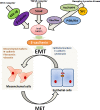Non-coding RNAs as emerging regulators of epithelial to mesenchymal transition in non-small cell lung cancer
- PMID: 28415568
- PMCID: PMC5482698
- DOI: 10.18632/oncotarget.16375
Non-coding RNAs as emerging regulators of epithelial to mesenchymal transition in non-small cell lung cancer
Abstract
Non-small cell lung cancer (NSCLC) remains a major health problem that patients suffer from around the world. The epithelial to mesenchymal transition (EMT) has attractive roles in increasing malignant potential and reducing sensitivity to conventional therapeutics in NSCLC cells. Meanwhile, it is now evident that non-coding RNAs (ncRNAs), primarily microRNAs and long non-coding RNAs contribute to tumorigenesis partially via regulating EMT. This article briefly summarizes current researches about EMT-related ncRNAs in NSCLC and discusses their crucial roles in the complex regulatory network. Also, the authors will show the evidence that ncRNAs not only contribute to cancer cells migration and invasion, but also take charge of the resistance of chemotherapy, radiotherapy and EGFR-TIKs. Then, we will further discuss the potential of inhibition of EMT via manipulating relevant ncRNAs to change our current treatment of NSCLC patients.
Keywords: epithelial-mesenchymal transition; long-coding RNA; microRNA; non-coding RNA; non-small cell lung cancer.
Conflict of interest statement
The authors declare no conflict of interest.
Figures


Similar articles
-
Loss of long noncoding RNA FOXF1-AS1 regulates epithelial-mesenchymal transition, stemness and metastasis of non-small cell lung cancer cells.Oncotarget. 2016 Oct 18;7(42):68339-68349. doi: 10.18632/oncotarget.11630. Oncotarget. 2016. PMID: 27577075 Free PMC article.
-
LncRNA PRNCR1 interacts with HEY2 to abolish miR-448-mediated growth inhibition in non-small cell lung cancer.Biomed Pharmacother. 2018 Nov;107:1540-1547. doi: 10.1016/j.biopha.2018.08.105. Epub 2018 Sep 5. Biomed Pharmacother. 2018. PMID: 30257372
-
MiR-145 and miR-203 represses TGF-β-induced epithelial-mesenchymal transition and invasion by inhibiting SMAD3 in non-small cell lung cancer cells.Lung Cancer. 2016 Jul;97:87-94. doi: 10.1016/j.lungcan.2016.04.017. Epub 2016 Apr 27. Lung Cancer. 2016. PMID: 27237033
-
Long non-coding RNAs: How to regulate the metastasis of non-small-cell lung cancer.J Cell Mol Med. 2020 Mar;24(6):3282-3291. doi: 10.1111/jcmm.15054. Epub 2020 Feb 12. J Cell Mol Med. 2020. PMID: 32048814 Free PMC article. Review.
-
The emerging role of noncoding RNAs in the EGFR signaling pathway in lung cancer.Pathol Res Pract. 2024 Jan;253:155016. doi: 10.1016/j.prp.2023.155016. Epub 2023 Dec 5. Pathol Res Pract. 2024. PMID: 38070221 Review.
Cited by
-
LncRNA DLX6-AS1 promotes the proliferation, invasion, and migration of non-small cell lung cancer cells by targeting the miR-27b-3p/GSPT1 axis.Onco Targets Ther. 2019 May 22;12:3945-3954. doi: 10.2147/OTT.S196865. eCollection 2019. Onco Targets Ther. 2019. PMID: 31190891 Free PMC article.
-
MicroRNAs in Lung Cancer Oncogenesis and Tumor Suppression: How it Can Improve the Clinical Practice?Curr Genomics. 2020 Aug;21(5):372-381. doi: 10.2174/1389202921999200630144712. Curr Genomics. 2020. PMID: 33093800 Free PMC article. Review.
-
Downregulation of long non-coding RNA LET predicts poor prognosis and increases Notch signaling in non-small cell lung cancer.Oncotarget. 2017 Dec 19;9(1):1156-1168. doi: 10.18632/oncotarget.23452. eCollection 2018 Jan 2. Oncotarget. 2017. PMID: 29416684 Free PMC article.
-
EMT-Mediated Acquired EGFR-TKI Resistance in NSCLC: Mechanisms and Strategies.Front Oncol. 2019 Oct 11;9:1044. doi: 10.3389/fonc.2019.01044. eCollection 2019. Front Oncol. 2019. PMID: 31681582 Free PMC article. Review.
-
lncRNA DLEU2 modulates cell proliferation and invasion of non-small cell lung cancer by regulating miR-30c-5p/SOX9 axis.Aging (Albany NY). 2019 Sep 20;11(18):7386-7401. doi: 10.18632/aging.102226. Epub 2019 Sep 20. Aging (Albany NY). 2019. PMID: 31541993 Free PMC article.
References
-
- Ferlay J, Soerjomataram I, Dikshit R, Eser S, Mathers C, Rebelo M, Parkin DM, Forman D, Bray F. Cancer incidence and mortality worldwide: sources, methods and major patterns in GLOBOCAN 2012. Int J Cancer. 2015;136:E359–86. - PubMed
-
- Hoffman PC, Mauer AM, Vokes EE. Lung cancer. The Lancet. 2000;355:479–85. - PubMed
Publication types
MeSH terms
Substances
LinkOut - more resources
Full Text Sources
Other Literature Sources
Medical
Research Materials
Miscellaneous

